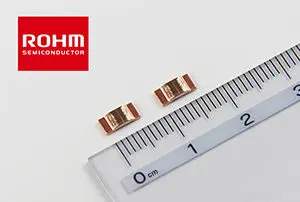source: Rohm news
Compact designs contribute to improved performance in high power applications. With its PSR100 series, ROHM offers a significantly more compact version of its proven PSR series. The PSR100 series ultra-low ohmic shunt resistors have a high-power capability and are suited to current measurement in automotive and industrial applications.
The new shunt resistors, which are based on a high-performance metal alloy as the resistive element, feature superior temperature coefficients (TCR) from 50ppm to 150ppm. Thanks to ROHM’s innovative precision welding technology, they deliver a high rated power of 3W coupled with an ultra-compact form factor of 6.35mm x 3.05mm. Their resistance range covers 0.3mΩ to 3.0mΩ. The resistance tolerance is specified with F (1%). The operating temperature range is –55°C to +170°C.
The PSR100 series is the ideal solution for automotive and industrial applications as well as many other areas with high requirements in terms of performance and size. These include for example on-board chargers, electronic compressors and EPS in motor vehicles in addition to UPS and base stations.
High power applications supported
Shunt resistors are widely used in the automotive and industrial sectors for measuring current in high power applications. Due to the increasing demand for electric vehicles and the need to provide greater safety and efficiency, the automotive sector is seeing a shift towards computerisation and electro-mechanical systems. This has led to an increasing number of small motors and ECUs being used in the vehicles, which in turn drives up the demand for compact shunt resistors that can support higher power. To cater to this demand, ROHM has expanded its PSR series of high power low-resistance shunt resistors.

Excellent temperature coefficient of resistance – even in the ultra-low resistance region
Generally, the lower the resistance, the higher the temperature coefficient of resistance (TCR). In line with this, ROHM used a high-performance alloy as a high-resistivity metal, which ensures superior TCR, even in the ultra-low resistance region. The latest version is currently available with resistances from as low as 0.3mΩ, thus facilitating a wider range of applications.

Circuit Diagram
Specifications
| Part No. | Size (mm) [inch] |
Rated Power (+70ºC) |
Resistance Tolerance |
Temperature* Coefficient of Resistance (ppm/ºC) |
Resistance Range (mΩ) |
Operating Temp. Range (Cº) |
|---|---|---|---|---|---|---|
| NEWPSR100 | 6.35 x 3.05 [2512] |
3W | F(±1%) | ±150 | 0.3 | -55ºC to + 170ºC |
| ±115 | 0.5 | |||||
| ±100 | 1.0 | |||||
| ±50 | 2.0, 3.0 | |||||
| PSR400 | 10 x 5.2 [3921] |
4W | F(±1%) | ±225 | 0.2◊ | |
| ±175 | 0.3, 0.5 | |||||
| ±75 | 1.0, 2.0, 3.0 | |||||
| PSR500 | 15 x 7.75 [5931] |
5W | F(±1%) | ±250 | 0.1◊ | |
| ±225 | 0.2 | |||||
| ±150 | 0.3, 0.4, 0.5 | |||||
| ±75 | 1.0, 2.0 |
◊ These products are under development, and therefore the specifications are subject to change without notice. Please contact a ROHM sales representative for more information.
* +20ºC to +125ºC
Terminology
TCR (Temperature Coefficient of Resistance)
The lower the value, the less resistance change with a change in ambient temperature. This makes it possible to suppress variations during device operation.

































